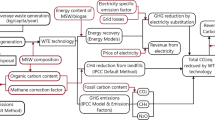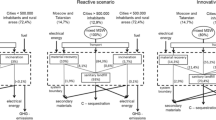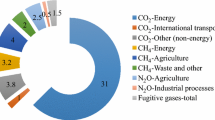Abstract
The goal in this study is to assess the greenhouse gas (GHG) emissions and the costs of municipal solid waste treatment and final disposal alternatives, in Maputo City, capital of Mozambique. Three scenarios were considered: first, the current practice of open dumping; second, the sole usage of sanitary landfilling; and third, comprising material recovery through recycling and biological treatment by composting or anaerobic digestion, and the usage of sanitary landfilling. The highest GHG emissions were observed in the second scenario with a released amount of 260,621 t of CO2-eq/year, followed by the current scenario with 201,112 t of CO2-eq/year. Both variants of the third scenario showed negative net emissions of −296,008 t of CO2-eq/year and −223,925 t of CO2-eq/year, due to the combination of GHG avoiding alternatives such as composting and biogas production as well as recycling. The cost assessment pointed towards the second scenario being the highest cost-saving scenario, requiring less than US$ 1 million/year and the current scenario as the most cost-intensive scenario, requiring around US$ 27 million/year—with a contribution from the cost of inaction of US$ 24 million/year. In addition, sensitivity analysis was performed by changing the waste compositing in relation to different income levels, which have verified the consistency of results. It also showed that with income increase in the future, GHG emissions will increase in the current and for the second scenario, while for the third scenario, the GHG emissions will reduce and the portion of recyclables will significantly increase.




Similar content being viewed by others
Notes
GHG calculator for solid waste ver. II-2013. Available in http://enviroscope.iges.or.jp/modules/envirolib/view.php?docid=4273.
References
Achillas, C., Moussiopoulos, N., Karagiannidis, A., Banias, G., & Perkoulidis, G. (2013). The use of multi-criteria decision analysis to tackle waste management problems: A literature review. Waste Management and Research, 31(2), 115–129.
Allen, C., & Jossias, E. (2011). WIEGO organizing brief no.6: Mapping of the policy context and Catadores Organizations in Maputo, Mozambique. Manchester: Women in Informal Employment: Globalizing and Organizing (WIEGO).
Associação Brasileira de Empresas de Limpeza Pública e Resíduos Especiais (ABRELPE), & International Solid Waste Association (ISWA). (2013). Solid waste: Guidelines for successful planning. Sao Paulo: ABRELPE & ISWA.
Barton, J. R., Issaias, I., & Stentiford, E. I. (2008). Carbon-making the right choice for waste management in developing countries. Waste Management, 28(4), 690–698.
Bjarnadóttir, H. J., Friðriksson, G. B., Johnsen, T., & Sletsen, H. (2002). Guidelines for the use of LCA in the waste management sector. Espoo. http://www.nordtest.org/register/techn/tlibrary/tec517/tec517.pdf
Boonrod, K., Towprayoon, S., Bonnet, S., & Tripetchkul, S. (2015). Enhancing organic waste separation at the source behavior: A case study of the application of motivation mechanisms in communities in Thailand. Resources, Conservation and Recycling, 95, 77–90.
Chang, J. (2004). Guatemala city landfill gas burning stove. http://www.its.caltech.edu/~kpickar/e105/papers/papers.htm
Chen, T.-C., & Lin, C.-F. (2008). Greenhouse gases emissions from waste management practices using Life Cycle Inventory model. Journal of Hazardous Materials, 155(1–2), 23–31.
Chong, T. L., Matsufuji, Y., & Hassan, M. N. (2005). Implementation of the semi-aerobic landfill system (Fukuoka method) in developing countries: A Malaysia cost analysis. Waste Management, 25(7), 702–711.
Couth, R., & Trois, C. (2010). Carbon emissions reduction strategies in Africa from improved waste management: A review. Waste Management, 30(11), 2336–2346.
Couth, R., & Trois, C. (2011). Waste management activities and carbon emissions in Africa. Waste Management, 31(1), 131–137.
Dahlman, K. (2009). Modeling sanitation scenarios in developing countries. A case study in Kumasi, Ghana. Swedish University of Agricultural Sciences. Retrieved from http://www.w-program.nu/filer/exjobb/Kristina_Dahlman.pdf
Dávila, J. D., Kyrou, E., Nuñez, T., & Sumich, J. (2008). Urbanisation and municipal development in Mozambique: Urban poverty and rural-urban linkages. London. http://siteresources.worldbank.org/INTDEBTDEPT/Resources/468980-1218567884549/5289593-1224797529767/Mozambique200808_01.pdf
Dias, S. (2011). Recycling in Belo Horizonte, Brazil—An overview of inclusive programming recycling of materials from domestic waste. WIEGO Policy Brief (Urban Policies), 1(3), 1–8.
dos Muchangos, L. S. (2012). A study of MSWM system in Maputo City, Mozambique—Learning experiences of Chongqing, China. Unpublished master’s thesis. Chongqing University, Chongqing.
dos Muchangos, L. S., Liu, Y., & Li, B. (2014). Comparative study on municipal solid waste management systems of Maputo City, Mozambique and Chongqing City, China. African Journal of Science, Technology, Innovation and Development, 6(4), 323–331.
dos Muchangos, L. S., Tokai, A., & Hanashima, A. (2017). Application of material flow analysis to municipal solid waste in Maputo City, Mozambique. Waste Management and Research, 35(3), 253–266.
Dulac, N. (2001). The organic waste flow in integrated sustainable waste management. In A. Scheinberg, (Ed.) Tools for decision-makers, experiences from the urban waste expertise programme (1995–2001), Gouda.
Elagroudy, S., Elkady, T., & Ghobrial, F. (2011). Comparative cost benefit analysis of different solid waste management scenarios in Basrah, Iraq. Journal of Environmental Protection, 2(5), 555–563.
Ferrão, D. A. G. (2006). Avaliação da Remoção e Eliminação dos Resíduos Sólidos na Cidade de Maputo. Moçambique: University of Cape Town.
Hazra, T., & Goel, S. (2009). Solid waste management in Kolkata, India: Practices and challenges. Waste Management, 29(1), 470–478.
Hedrick-Wong, Y., & Angelopulo, G. (2011). The challenges of urbanization in sub-Saharan Africa: A tale of three cities. MasterCard Worldwide.
Hogg, D., & Eunomia Research and Consulting. (2002). Costs for municipal waste management in the EU. Final report to Directorate General Environment, European Commission. http://ec.europa.eu/environment/waste/studies/eucostwaste_management.htm
Hoornweg, D., & Bhada-Tata, P. (2012). What a waste. World Bank: A global review of solid waste management.
Ikhlayel, M., Higano, Y., Yabar, H., & Mizunoya, T. (2016). Introducing an integrated municipal solid waste management system: Assessment in Jordan. Journal of Sustainable Development, 9(2), 43.
International Solid Waste Association (ISWA) (2014), Waste-to-energy research and technology council (WTERT), Regional Solid Waste Exchange of Information and Expertise Network (SWEEPNET), University of Leeds, and Solid Waste Management in Asia and Pacific Islands (SWAPI). (2014). Waste Atlas. The world’s 50 biggest dumpsites. 2014 Report.
Jenkins, P. (2000). City profile: Maputo. Cities, 17(3), 207–218.
Laurent, A., Bakas, I., Clavreul, J., Bernstad, A., Niero, M., Gentil, E., et al. (2014). Review of LCA studies of solid waste management systems—Part I: Lessons learned and perspectives. Waste Management, 34(3), 573–588.
Maputo Municipal Council. (2008). Plano Director—Gestão de resíduos sólidos urbanos na Cidade de Maputo (Master plan of municipal solid waste management in Maputo City). Maputo: Conselho Municipal da Cidade de Maputo. (in Portuguese).
Masood, M., Barlow, C. Y., & Wilson, D. C. (2014). An assessment of the current municipal solid waste management system in Lahore, Pakistan. Waste Management and Research, 32(9), 834–847.
Matthews, E. (2012). Good news from the dump methane emissions from solid waste: Current conditions and future prospects. Boston: Clean Air Task Force.
Mavropoulos, A., Cohen, P., Greedy, D., Plimakis, S., Marinheiro, L., Law, J., & Loureiro, A. (2016). A roadmap for closing waste dumpsites the world’s most polluted places. Vienna: ISWA.
Mbiba, B. (2014). Urban solid waste characteristics and household appetite for separation at source in Eastern and Southern Africa. Habitat International, 43, 1–11.
Menikpura, N., & Sang-Arun, J. (2013). User manual estimation tool for greenhouse gas (GHG) emissions from municipal solid waste (MSW) management in a life cycle perspective.
Mertanen, S. T., Langa, J. M., & Ferrari, K. (2013). Catadores de Lixo de Maputo. Quem sao e como trabalham.
Ministry of the Environment of Japan. (2012). Solid waste management and recycling technology of Japan—Toward a sustainable society. Tokyo.
Morrissey, A. J., & Browne, J. (2004). Waste management models and their application to sustainable waste management. Waste Management, 24(3), 297–308.
National Statistics Institute. (2015). Population projections for 2007 to 2014. Government of Mozambique: http://www.ine.gov.mz/estatisticas/esta-tisticas-demograficas-e-indicadores-sociais/projeccoes-da-populacao/populacao-projectada-por-distritos-maputo-cidade-2007_2040.xls/view. Accessed June 13, 2015.
Nishtala, S., & Solano-mora, E. (1997). Description of the material recovery facilities process model design, cost, and life-cycle inventory. Research Triangle Institute, North Carolina State University.
Olar, Z. (2003). Urban solid waste management: Waste reduction in developing nations. Houghton, MI: Michigan Technological University.
OANDA Corporation. (2017). Historial rates. http://www.oanda.com/currency/historical-rates/. Accessed August 10, 2017.
Polzer, V. R., & Pisani, M. A. J. (2015). The challenge of solid waste collection in precarious settlements in São Paulo. Brazil, 1, 1–9. doi:10.5348/C01-2015-1-RA-1.
Premakumara, D. G. J., Canete, A. M. L., Nagaishi, M., & Kurniawan, T. A. (2014). Policy implementation of the Republic Act (RA) No. 9003 in the Philippines: A case study of Cebu City. Waste Management, 34(6), 971–979.
Pressley, P. N., Levis, J. W., Damgaard, A., Barlaz, M. A., & DeCarolis, J. F. (2015). Analysis of material recovery facilities for use in life-cycle assessment. Waste Management, 35, 307–317. doi:10.1016/j.wasman.2014.09.012.
Scarlat, N., Motola, V., Dallemand, J. F., Monforti-Ferrario, F., & Mofor, L. (2015). Evaluation of energy potential of municipal solid waste from African urban areas. Renewable and Sustainable Energy Reviews, 50, 1269–1286.
Scheinberg, A., Simpson, M., Gupt, Y., Anschütz, J., Haenen, I., Tasheva, E., et al. (2010). Economic aspects of the informal sector in solid waste management. Eschborn: GTZ (German Technical Cooperation).
Secretariat of the Pacific Regional Environment Programme (SPREP), & Japan International Cooperation Agency (JICA). (2010). A Practical Guide to Landfill Management in Pacific Island Countries and Territories. Apia: SPREP.
Segala, K., Opressa, I., & Palalane, J. (2008). Gestão de Resíduos Sólidos. Urbanização e Desenvolvimento Municipal em Moçambique. Rio de Janeiro, Brazil.
Stretz, J. (2012). Economic Instruments in Solid Waste Management. In E. Gunsilius & GIZ (Eds.), Case Study Maputo, Mozambique. Maputo: Deutsche Gesellschaft für Internationale Zusammenarbeit (GIZ) GmbH Concepts for Sustainable Waste Management.
Tai, J., Zhang, W., Che, Y., & Feng, D. (2011). Municipal solid waste source-separated collection in China: A comparative analysis. Waste Management, 31(8), 1673–1682.
Tanaka, N., Tojo, Y., & Matsuto, T. (2005). Past, present, and future of MSW landfills in Japan. Journal of Material Cycles and Waste Management, 7(2), 104–111.
Tas, A., & Belon, A. (2014). A Comprehensive review of the municipal solid waste sector in Mozambique: Background documentation for the formulation of nationally appropriate mitigation actions in the waste sector in Mozambique. Nairobi, Kenya; Maputo. www.carbonafrica.co.ke
The Intergovernmental Panel on Climate Change (IPCC). (2006). In S. Eggleston, L. Buendia, K. Miwa, T. Ngara, & K. Tanabe (Eds.) 2006 IPCC guidelines for national greenhouse gas inventories, waste. (Vol. 5). Hayama: Institute for Global Environmental Strategies (IGES) on behalf of the IPCC. http://www.ipcc-nggip.iges.or.jp/public/2006gl/vol5.html
United Nations Environment Programme (UNEP). (2005a). Training module: Closing an open dumpsite and shifting from open dumping to controlled dumping and to sanitary land filling. Osaka/Shiga: United Nations Environment Programme.
United Nations Environment Programme (UNEP). (2005b). Solid Waste Management. Osaka/Shiga: United Nations Environment Programme.
United Nations Human Settlements Programme (UN-HABITAT). (2010). Mozambique Cities Profile. Maputo, Nacala and Manica. Nairobi: United Nations Human Settlements Programme.
Wang, L., Hu, G., Gong, X., & Bao, L. (2009). Emission reductions potential for energy from municipal solid waste incineration in Chongqing. Renewable Energy, 34(9), 2074–2079.
Wilson, D., Rodic, L., Modak, P., Soos, R., Rogero, A. C., Velis, C., et al. (2015). In T. Cannon (Ed.), Global waste management outlook. United Nations Environment Programme (UNEP). http://www.unep.org/ietc/Portals/136/Publications/Waste-Management/GWMO-report/GWMO-full-report.pdf
Wilson, D. C., Velis, C., & Cheeseman, C. (2006). Role of informal sector recycling in waste management in developing countries. Habitat International, 30(4), 797–808.
World Bank. (2004). Handbook for the Preparation of Landfill Gas to Energy Projects in Latin America and the Caribbean The World Bank—ESMAP (Vol. 19399). Waterloo, Ontario: The International Bank for Reconstruction and Development/The World Bank.
World Bank. (2017). World Bank Country and lending groups. https://datahelpdesk.worldbank.org/knowledgebase/articles/906519-world-bank-country-and-lending-groups. Accessed January 19, 2017
Yadav, P., & Samadder, S. R. (2014). Life cycle assessment of solid waste management options: A review. Recent Research in Science and Technology, 6(1), 113–116.
Yay, A. S. E. (2015). Application of life cycle assessment (LCA) for municipal solid waste management: A case study of Sakarya. Journal of Cleaner Production, 94, 284–293.
Zen, I. S., Ahamad, R., & Omar, W. (2013). No plastic bag campaign day in Malaysia and the policy implication. Environment, Development and Sustainability, 15(5), 1259–1269.
Zen, I. S., Noor, Z. Z., & Yusuf, R. O. (2014). The profiles of household solid waste recyclers and non-recyclers in Kuala Lumpur, Malaysia. Habitat International, 42, 83–89.
Zhao, W., Huppes, G., & van der Voet, E. (2011). Eco-efficiency for greenhouse gas emissions mitigation of municipal solid waste management: A case study of Tianjin, China. Waste Management, 31(6), 1407–1415.
Zurbrügg, C., Caniato, M., & Vaccari, M. (2014). How assessment methods can support solid waste management in developing countries—A critical review. Sustainability, 6, 545–570.
Acknowledgements
This study was conducted under the postgraduate scholarship programme for international students, offered by the Ministry of Education, Culture, Sports, Science, and Technology of Japan (Grant No. 130783). We thank Dr Nirmala Menikpura, from the Institute for Global Environmental Strategies, (IGES), for promptly providing the requested information, and for including Mozambique into the country list of the greenhouse gas estimation tool. The authors also acknowledge the valuable comments and improvement suggestions from the anonymous reviewers of the manuscript.
Author information
Authors and Affiliations
Corresponding author
Rights and permissions
About this article
Cite this article
dos Muchangos, L.S., Tokai, A. & Hanashima, A. Greenhouse gas emissions and cost assessments of municipal solid waste treatment and final disposal in Maputo City. Environ Dev Sustain 21, 145–163 (2019). https://doi.org/10.1007/s10668-017-0027-5
Received:
Accepted:
Published:
Issue Date:
DOI: https://doi.org/10.1007/s10668-017-0027-5




